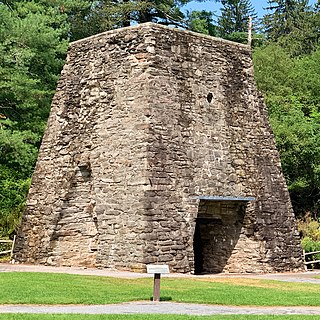Related Research Articles

The Lehigh Crane Iron Company was a major ironmaking firm in the Lehigh Valley from its founding in 1839 until its sale in 1899. It was founded under the patronage of Josiah White and Erskine Hazard, and financed by their Lehigh Coal & Navigation Company, which hoped to promote the then-novel technique of smelting iron ore with anthracite coal. This was an important cost and energy savings technique, since either an expensive charcoaling nor coke producing process and transport costs was totally eliminated so produced a great acceleration in the underpinnings of the American industrial revolution.

The Nittany and Bald Eagle Railroad is a short line railroad that operates 73 miles (117 km) of track in Blair, Centre, and Clinton counties in Pennsylvania in the United States. It is part of the North Shore Railroad System.
The Bellefonte Central Railroad was a shortline connecting Bellefonte and State College, Pennsylvania. Constructed in the late 19th century to haul local iron ore to furnaces in the Bellefonte region, it later hauled freight traffic to Penn State and lime for steelmaking from local quarries. The line to State College was abandoned in 1974, and most of the remaining railroad in 1984, but a small portion is still used by the Nittany and Bald Eagle Railroad.

The Thomas Iron Company was a major iron-making firm in the Lehigh Valley from its organization in 1854 until its decline and eventual dismantling in the early 20th century. The firm was named in honor of its founder, David Thomas, who had emigrated to the United States in 1839 to introduce hot blast iron making in the Lehigh Valley, and now embarked on an independent ironmaking venture. The company's main and original plant was in Hokendauqua, Pennsylvania, which grew up around it; it also came to own blast furnaces and railroads elsewhere in the Lehigh Valley and mines in both Pennsylvania and New Jersey. Changes in the iron industry in the early Twentieth Century left Thomas Iron struggling to compete, and after a failed attempt at modernization and revival from 1913 to 1916, the company's assets were sold and largely dismantled during the 1920s.
The Catasauqua and Fogelsville Railroad was built in the 1850s to transport iron ore from local mines in Lehigh and later Berks County to furnaces along the Lehigh River. Originally owned by two iron companies, the railroad later became part of the Reading system, and parts of it remain in operation today.
The Central Railroad of Pennsylvania was a short railroad of 27.3 miles (43.9 km) built to connect Bellefonte, Pennsylvania with the Beech Creek Railroad at Mill Hall, Pennsylvania. Sustained by shipments from the Bellefonte iron industry, the abandonment of the iron furnaces there led to its demise in 1918.

Scotia was a village in Patton Township, Centre County, Pennsylvania, at 40°47′59″N77°56′46″W. Although the community was called Scotia, the name of the local post office was Benore.
The Mont Alto Rail Road was a railroad in Franklin County, Pennsylvania, originally built to connect the blast furnaces of the Mont Alto Iron Company to the Cumberland Valley Railroad. It was later extended south to reach Waynesboro.

The Nittany Valley is an eroded anticlinal valley in the central portion of Centre County, Pennsylvania in the United States. It is separated from the Bald Eagle Valley by Bald Eagle Mountain and from Penns Valley by Mount Nittany. The valley is closed to the north by a high plateau that joins these two mountain ridges, but is open to the south at the southern terminus of Mount Nittany. The valley drains to Bald Eagle Creek through water gaps in Bald Eagle Mountain formed by Spring Creek and Fishing Creek, along with smaller streams running through Curtain Gap and Howard Gap. The northwest side of the valley between the Bald Eagle Mountain ridge and the lower Sand Ridge is also known as the "Little Nittany Valley".

The Bellefonte and Snow Shoe Railroad was a coal-hauling railroad in Centre County, Pennsylvania. Begun in 1859, it came under the control of the Pennsylvania Railroad in 1881. Closing of mines in the 1930s resulted in the decline of traffic on the railroad, which was abandoned in 1959.
Graysdale is an unincorporated community in Patton Township, Centre County, Pennsylvania, located at 40.8130°N 77.9548°W.
John Wesley Gephart was a Bellefonte, Pennsylvania lawyer and industrialist. Educated in Bellefonte and at Princeton University, Gephart's diligence and intelligence were already marked when he was admitted to the bar at the end of 1876 and joined the Bellefonte law practice of James A. Beaver in 1877. He took a prominent part in the civic and moral life of the town, and enjoyed a reputation as a skillful lawyer and charismatic orator. In 1891, he became president of the newly organized Valentine Iron Company, and thereafter became increasingly devoted to furthering industry and commerce in his home town. He laid aside his legal practice in 1893, after becoming the superintendent of the new Central Railroad of Pennsylvania, to become a full-time industrialist.

Nittany Furnace, known earlier as Valentine Furnace, was a hot blast iron furnace located in Spring Township, Centre County, Pennsylvania, United States. Placed in operation in 1888 on the site of an older furnace, it was an important feature of Bellefonte economic life until it closed in 1911, no longer able to compete with more modern steel producers.
The Bald Eagle Valley Railroad was a subsidiary of the Pennsylvania Railroad which owned several rail lines in central Pennsylvania. It had its genesis in the Tyrone and Lock Haven Railroad, a financially troubled railroad chartered in 1857, which was unable to complete more than a small portion of its line before it was reorganized as the Bald Eagle Valley and funded by the PRR in 1861. Completed from Tyrone to Lock Haven in 1865, it was completely controlled by the PRR and did not operate independently. However, it retained its corporate existence for some time, acquiring branch lines into the Snowshoe coal region and an extension from Bellefonte to Lemont before being merged into the PRR in 1908.

The Bald Eagle and Spring Creek Navigation Company was a canal company in central Pennsylvania intended to link the iron industry of Bellefonte, Pennsylvania, with the Pennsylvania canal system. Opened for half its length in 1837, the remainder of the canal was not completed until 1848. Destroyed by flooding in 1865, it was not rebuilt; a paralleling railroad completed that year replaced it.
The Lewisburg and Tyrone Railroad, previously the Lewisburg, Centre and Spruce Creek Railroad, was a subsidiary of the Pennsylvania Railroad (PRR) in central Pennsylvania. Originally intended to connect the Susquehanna Valley with Tyrone and the ore lands to its northeast, it was built in two discontinuous and never-connected pieces, one from Tyrone to Fairbrook and one from Lewisburg to Lemont. These served as lightly trafficked branches of the PRR into the early 20th Century. The line from Tyrone to Fairbrook passed into the hands of the short line Bellefonte Central Railroad in 1927, but the PRR's manipulations ensured its abandonment in 1941. The line between Lewisburg and Lemont was severed in 1970 and was gradually cut further back towards Montandon. Regular service ended on the last remaining part of the line in 1997, and it was abandoned in 2008.
Edmund Blanchard was a lawyer and prominent businessman in Centre County, Pennsylvania. He was an early promoter of rail transportation in the area.

Bellefonte Furnace was a hot blast iron furnace located in Bellefonte, Pennsylvania. Founded in 1888, it was the first hot blast, coke-fueled iron furnace to be built in Centre County, Pennsylvania. While its founders hoped to transform Centre County's iron industry with modern technology, the furnace struggled to operate at a profit and was out of operation from 1893 until 1899. Thereafter, it operated more or less continuously until 1910, and was demolished four years later. It should not be confused with the charcoal-fueled Bellefonte Furnace and Forge on Logan Branch, which was replaced by Valentine Furnace.

The Ironton Railroad was a shortline railroad in Lehigh County, Pennsylvania. Originally built in 1861 to haul iron ore and limestone to blast furnaces along the Lehigh River, traffic later shifted to carrying Portland cement when local iron mining declined in the early 20th century. Much of the railroad had already been abandoned when it became part of Conrail in 1976, and the last of its trackage was removed in 1984.

The Pine Grove Iron Works was a southcentral Pennsylvania smelting facility during the Industrial Revolution. The works is notable for remaining structures that are historical visitor attractions of Pine Grove Furnace State Park, including the furnace stack of the Pine Grove Furnace. The site was listed on the National Register of Historical Places on April 13, 1977 for its significance in architecture and industry. It includes seven contributing buildings, two structures, fourteen sites, and two objects.
References
- 1 2 3 4 Taber, Thomas T. III (1987). Railroads of Pennsylvania Encyclopedia and Atlas. Thomas T. Taber III. p. 78. ISBN 0-9603398-5-X.
- 1 2 Mitchell, J. Thomas (1936). "The Iron Industries of Centre County". Democratic Watchman. Archived from the original on 2011-07-20. Retrieved 2007-01-28.
- ↑ "Supreme Court's Latest Decisions". Keystone Gazette. 1895-10-11. p. 1. Archived from the original on 2013-01-04. Retrieved 2007-01-28.
- ↑ "J.W. Gephart Resigned". Keystone Gazette. 1895-11-08. p. 4. Archived from the original on 2013-01-04. Retrieved 2007-01-28.